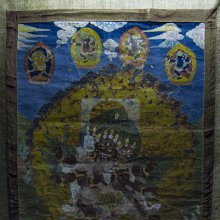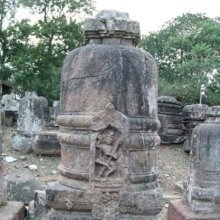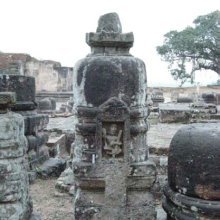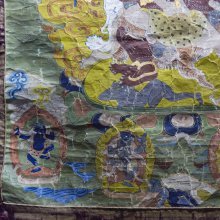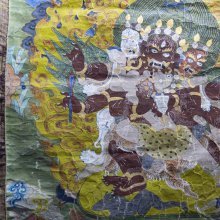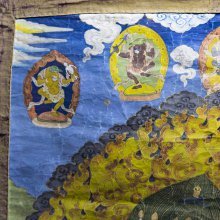Heruka: 14 definitions
Introduction:
Heruka means something in Buddhism, Pali, Hinduism, Sanskrit. If you want to know the exact meaning, history, etymology or English translation of this term then check out the descriptions on this page. Add your comment or reference to a book if you want to contribute to this summary article.
Images (photo gallery)
(+17 more images available)
In Hinduism
Shaktism (Shakta philosophy)
Source: Google Books: Manthanabhairavatantram1) Heruka (हेरुक) refers to one of the eight Guardians (kṣetrapāla-aṣṭaka) associated with Kāmākhya (corresponding to the eastern face of Bhairava), according to the Manthānabhairavatantra, a vast sprawling work that belongs to a corpus of Tantric texts concerned with the worship of the goddess Kubjikā.—[...] The eight Guardians (kṣetrapālāṣṭaka): Heruka, Kumāra, Kamala, Ṣaṇmukhāntaka, Kadamba, Lalita, Lambodara, Devasena.
2) Heruka (हेरुक) is associated with Pinākin: one of the nine Bhairava associated with the nine energies of Navātman, according to the Manthānabhairavatantra.—[Note: this passage is drawn from the Gurukramasūtra]—Another way in which the nine energies of Navātman may be understood are as nine aspects of the Command that generates the Bhairavas corresponding to its nine letters. [...] In this case Navātman is SHKṢMLVRYŪ(Ṃ): [...] Pinākin (La) originated in Heruka. [...] (This) is the excellent teacher within the tradition. He who knows the teacher here is the delight of Kula.

Shakta (शाक्त, śākta) or Shaktism (śāktism) represents a tradition of Hinduism where the Goddess (Devi) is revered and worshipped. Shakta literature includes a range of scriptures, including various Agamas and Tantras, although its roots may be traced back to the Vedas.
In Buddhism
Tibetan Buddhism (Vajrayana or tantric Buddhism)
Source: archive.org: The Indian Buddhist IconographyHeruka (हेरुक) refers to one of the various emanations of Akṣobhya having their Sādhana described in the 5th-century Sādhanamālā (a collection of sādhana texts that contain detailed instructions for rituals).—His Colour is blue; his Symbols are the vajra and kapāla; his Variety is single; has two arms.—Heruka is one of the most popular deities of the Buddhist pantheon and a regular Tantra, the Heruka-antra, is devoted to his worship. Heruka is worshipped singly as well as in yab-yum. When he is in yab-yum he is generally known as Hevajra and in this form he is popular in Tibet.
The Dhyāna (meditation instructions) of Heruka described in the Sādhanamālā as follows:
Source: academia.edu: The Structure and Meanings of the Heruka Maṇḍala“The worshipper should conceive himself as the god (Heruka) who stands on a corpse in the ardhaparyaṅka attitude. He is well-clad in human skin and his body is besmeared with ashes. He wields the vajra in the right hand and from his left shoulder hangs the khaṭvāṅga with a flowing banner, like a sacred thread. He carries in his left hand the kapāla full of blood. His necklace is beautified by a chain of half-a-hundred severed heads. His face is slightly distorted with bare fangs and blood-shot eyes, His brown hair rises upwards and forms into a crown which bears the effigy of Akṣobhya. He wears a kuṇḍala and is decked in ornaments of bones. His head is beautified by five skulls. He bestows Buddhahood and protects the world from the Māras (wicked beings)”
[In another sādhana for the worship of this particular kind of Heruka the khaṭvāṅga is described as being marked with a vajra of five thongs and decorated with a banner with jingling bells, human heads and double lotus, the lower part of the khaṭvāṅga resembling the vajra with one thong. The sādhana does not mention the number of heads in the necklace, but says simply that they are strung with guts. His left leg rests on the double lotus (and not on the corpse) while the right is placed on the left thigh in a dancing attitude.]
1) Heruka (हेरुक), together with his consort Vārāhī, is the main deity of the Herukamaṇḍala described in the 10th century Ḍākārṇava chapter 15. Heruka is positioned in the Lotus (padma) at the center; He is the origin of all heroes; He has 17 faces (with three eyes on each) and 76 arms; He is half black and half green in color; He is dancing on a flaming sun placed on Bhairava and Kālarātrī. In the Herukamaṇḍala, the east division of the entire maṇḍala is blackish dark-blue in color; the north division, green; the west division, red; and the south division, yellow. Heruka is the origin of all heroes, and Vārāhī is the origin of all Ḍākinīs.
2) Heruka (हेरुक) is the name of a Vīra (hero) who, together with the Ḍākinī named Suvīrā forms one of the 36 pairs situated in the Vajracakra, according to the same work. Accordingly, the vajracakra refers to one of the four divisions of the sahaja-puṭa (‘innate layer’), situated within the padma (lotus) in the middle of the Herukamaṇḍala. The 36 pairs of Ḍākinīs and Vīras [viz., Heruka] each have one face and four arms; they hold a skull bowl, a skull staff, a small drum and a knife; they are dark-bluish-black in color.
Source: OSU Press: Cakrasamvara SamadhiHeruka (हेरुक) is the name of a Ḍāka (male consort) and one of the deities of the Cakrasaṃvara-maṇḍala or Saṃvaramaṇḍala of Abhayākaragupta’s Niṣpannayogāvalī, p. 45 and n. 145; (Cf. Cakrasaṃvaratantra, Gray, David B., 2007).—The Cakrasaṃvara mandala has a total of sixty-two deities. [...] Three concentric circles going outward, the body, speech and mind wheels (kāya-vāka-citta), in the order: mind (blue), speech (red), and body (white), with eight Ḍākinīs each in non-dual union with their Ḍākas, "male consorts".
Associated elements of Suvīrā and Heruka:
Circle: kāyacakra (body-wheel) (white);
Ḍākinī (female consort): Suvīrā;
Ḍāka (male consort): Heruka;
Bīja: naṃ;
Body-part: feet;
Pīṭha: Nagara;
Bodily constituent: medas (sweat);
Bodhipakṣa (wings of enlightenment): upekṣābodhyaṅga (awakening of equanimity).
Heruka (हेरुक) is positioned in the center of the Lotus in the Sahaja (“innate”) layer of the Herukamaṇḍala: a five-fold maṇḍala that is widely taught in the scriptures belonging to the Saṃvara scriptural tradition.—Heruka and Vajravārāhī, the Lord and Mistress of the whole herukamaṇḍala, are situated in sexual union at the center of the lotus, the innermost of the Sahaja Layer.
Heruka in the Ḍākārṇava has seventeen faces (with three eyes on each) and seventy-six arms. His body is half black and half green The four faces looking toward the east, south, west, and north directions are colored black, yellow, red, and green, respectively, and the other thirteen faces are black like the front (east) face He has twisted locks of hair on which a crossed vajra and a half moon are fixed. He is grinning. He stands on Bhairava and Kālarātrī and is dancing. He is adorned with a string of five hairless heads as a headband, six seals, a garland of a hundred hairless heads as a necklace, sounding armlets and anklets, a garment made of some tiger skin, and a line of bodily hair on the body.
Heruka holds the following objects in his thirty-eight right hands:
- Elephant skin (danticarman),
- Womb hand gesture (yonimudrā),
- Vajra (vajra),
- Asi sword (asi),
- Kunta lance (kunta),
- Trident (triśūla),
- Axe (paraśu),
- Knife (kartti),
- Arrow (bāṇa),
- Pike-spiked [corpse] (śūlabhinna),
- Hammer (mudgara),
- Discus (cakra),
- Small drum (ḍamaru),
- Short sword (churikā),
- Club (ḍaṇḍa),
- Short javelin (bhiṇḍipālaka),
- Conch shell (śaṅkha),
- Copper trumpet or horn (kāhala),
- Short club (ḍaṇḍikā),
- Tail-feather of a peacock (mayūrapicchikā),
- Crow’s feather quill (kākapakṣakūcikā),
- Fire pit (agnikuṇḍī),
- Mountain (parvata),
- Stick (laguḍā),
- Mirror (darpaṇa),
- Lute (vīṇā),
- Foot (gulpha),
- Hand (pāṇi),
- Lungs (phupphusa),
- Small intestine (antra),
- Planet Rāhu (rāhu),
- Iron chain (nigaḍa),
- Wooden fetters (haḍi),
- Dubhūṣa (or durbhūṣa),
- Fish trap (jālikā),
- Decapitated corpse (kabandha),
- Flaming sesamum (jvālātaila),
- Physical Bhairava (bhairavarūpa).
Heruka holds the following objects in his thirty-eight left hands:
- Elephant skin (danticarman),
- Womb hand gesture (yonimudrā),
- Bell (ghaṇṭā),
- Shield (kheṭa),
- Tusk (danta),
- Pestle (muṣala),
- Noose (pāśa),
- Skull bowl (kapāla),
- Bow (dhanus),
- Skull staff (khaṭvā˙nga),
- Scripture (pusta),
- Bucklers (piṭṭāni),
- Threatening hand gesture (tarjanī),
- String of jingle bells (ghurghurāmālā),
- Chain (śṛ˙nkhalā),
- Rock (śilā),
- Powders from a charnel ground (śmaśānadhūlikā),
- Bhoka,
- Ḍakā drum (for ḍhakkā),
- Wet skin (ardracarman),
- Dangling hair braid (lambitakacaḍorikā),
- Tinder for a funeral pyre (codanacitikāṣṭhī),
- Anus (gudā),
- Shield (pharī),
- Head (mastaka),
- Skeleton (kaṅkāla),
- Rātrikā sickle (rātrikā),
- Eye (netra),
- Kidney (bukka for vṛkka),
- Large intestine (guṇavartikā),
- Saturn (śanaiścara),
- Stake (kīlaka),
- Citron (bījapūraka),
- Saw (pattraka),
- Needle (sūci),
- Full-body skin (kāyacarman),
- Cloud with rain (meghavṛṣṭi),
- Wooden hook (vṛkṣā˙nkuśa) ,

Tibetan Buddhism includes schools such as Nyingma, Kadampa, Kagyu and Gelug. Their primary canon of literature is divided in two broad categories: The Kangyur, which consists of Buddha’s words, and the Tengyur, which includes commentaries from various sources. Esotericism and tantra techniques (vajrayāna) are collected indepently.
General definition (in Buddhism)
Source: archive.org: The Indian Buddhist Iconography (b)Heruka (हेरुक) is one of the most popular deities of the Buddhist pantheon and a regular Tantra, the Heruka Tantra, is devoted to his worship. Heruka is worshipped singly as well as in yab-yum. When he is in yab-yum he is generally known as Hevajra and in this form he is popular in Tibet, Many of his forms are described in the Sādhanamālā
Languages of India and abroad
Sanskrit dictionary
Source: DDSA: The practical Sanskrit-English dictionaryHeruka (हेरुक).—
1) An attendant on Śiva.
2) Name of Gaṇeśa.
3) Name of a Buddha (= cakrasambara).
Derivable forms: herukaḥ (हेरुकः).
Source: Cologne Digital Sanskrit Dictionaries: Edgerton Buddhist Hybrid Sanskrit DictionaryHeruka (हेरुक).—name of a deity: Sādhanamālā 146.4 et passim.
Source: Cologne Digital Sanskrit Dictionaries: Shabda-Sagara Sanskrit-English DictionaryHeruka (हेरुक).—m.
(-kaḥ) 1. An attendant on Mahakala, or Siva in that form. 2. An inferior divinity of the Baud'dhas. E. hi to go, uka Unadi aff., ruṭ augment.
Source: Cologne Digital Sanskrit Dictionaries: Benfey Sanskrit-English DictionaryHeruka (हेरुक).—m. An attendant on Śiva.
Source: Cologne Digital Sanskrit Dictionaries: Monier-Williams Sanskrit-English Dictionary1) Heruka (हेरुक):—m. Name of Gaṇeśa, [Kālikā-purāṇa]
2) of an attendant on Mahā-kāla or Śiva, [cf. Lexicographers, esp. such as amarasiṃha, halāyudha, hemacandra, etc.]
3) of an inferior Buddha, [Buddhist literature]
4) [plural] Name of a class of heretics, [cf. Lexicographers, esp. such as amarasiṃha, halāyudha, hemacandra, etc.]
5) Herukā (हेरुका):—[from heruka] f. a species of plant, [Atharva-veda Paddh.]
Source: Cologne Digital Sanskrit Dictionaries: Yates Sanskrit-English DictionaryHeruka (हेरुक):—(kaḥ) 1. m. An attendant on Shiva; a Buddhist.
[Sanskrit to German]
Sanskrit, also spelled संस्कृतम् (saṃskṛtam), is an ancient language of India commonly seen as the grandmother of the Indo-European language family (even English!). Closely allied with Prakrit and Pali, Sanskrit is more exhaustive in both grammar and terms and has the most extensive collection of literature in the world, greatly surpassing its sister-languages Greek and Latin.
Kannada-English dictionary
Source: Alar: Kannada-English corpusHēṟuka (ಹೇಱುಕ):—[noun] = ಹೇಱು [heru]2 - 2.
Kannada is a Dravidian language (as opposed to the Indo-European language family) mainly spoken in the southwestern region of India.
See also (Relevant definitions)
Starts with: Herukabhidhana, Herukabhyudaya, Herukamandala, Herukara, Herukatantra, Herukavajra.
Ends with: Akashaheruka, Akasheruka, Baheruka, Bhairambhaheruka, Cittaheruka, Dasheruka, Dombiheruka, Dravaheruka, Jnanaheruka, Jvalaheruka, Kasheruka, Kayikaheruka, Laghuheruka, Mahavajraheruka, Nanaheruka, Padmaheruka, Samvaraheruka, Shriheruka, Vaggheruka, Vishuddhaheruka.
Full-text (+381): Nayaka, Laghuheruka, Kayika, Drava, Jnanaheruka, Padmaheruka, Cittaheruka, Bhairambha, Vajrakila, Akashaheruka, Jvalaheruka, Vaggheruka, Kayikaheruka, Bhairambhaheruka, Akasaka, Dravaheruka, Vajradaka, Nanaheruka, Mahavajraheruka, Samvaraheruka.
Relevant text
Search found 12 books and stories containing Heruka, Herukā, Hēṟuka; (plurals include: Herukas, Herukās, Hēṟukas). You can also click to the full overview containing English textual excerpts. Below are direct links for the most relevant articles:
Guhyagarbha Tantra (with Commentary) (by Gyurme Dorje)
Text 17.5 (Commentary) < [Chapter 17 (Text And Commentary)]
Text 17.7 (Commentary) < [Chapter 17 (Text And Commentary)]
Text 21.7 (Commentary) < [Chapter 21 (Text And Commentary)]
The Great Chariot (by Longchenpa)
Part 4 - The particular details < [E. Knowing what is to be abandoned and accepted, and how the siddhis are received]
Part 3e.2a - The self-existing nirmanakaya < [B. The explanation of the kayas and wisdoms]
C. The dedication of merit < [Chapter IX - Unifying the Developing Stage and the Perfecting Stage]
The Indian Buddhist Iconography (by Benoytosh Bhattachacharyya)
Figure 125 - Emanations of Akṣobhya: Heruka
Figure 159-160 - Emanations of Vairocana: Vajravārāhī
Stupas in Orissa (Study) (by Meenakshi Chauley)
Emanations of Aksobhya < [Chapter 5]
Buddhist Icons as depicted on the Stupas (Introduction) < [Chapter 5]
Shakti and Shakta (by John Woodroffe)
Chapter XXVIII - Matam Rutra (the Right and Wrong Interpretation) < [Section 3 - Ritual]
Chapter XXV - Varṇamālā (the Garland of Letters) < [Section 3 - Ritual]
Blue Annals (deb-ther sngon-po) (by George N. Roerich)
Chapter 10 - Phagmodru Lineage (xii): spyan snga bsod nams bzang po ba < [Book 8 - The famous Dakpo Kagyü (traditions)]
Chapter 10 - Phagmodru Lineage (iv): gcung bcu gnyis pa < [Book 8 - The famous Dakpo Kagyü (traditions)]
Chapter 8 - Second incarnation series (iv): mkhas grub dar rgyal ba < [Book 8 - The famous Dakpo Kagyü (traditions)]
